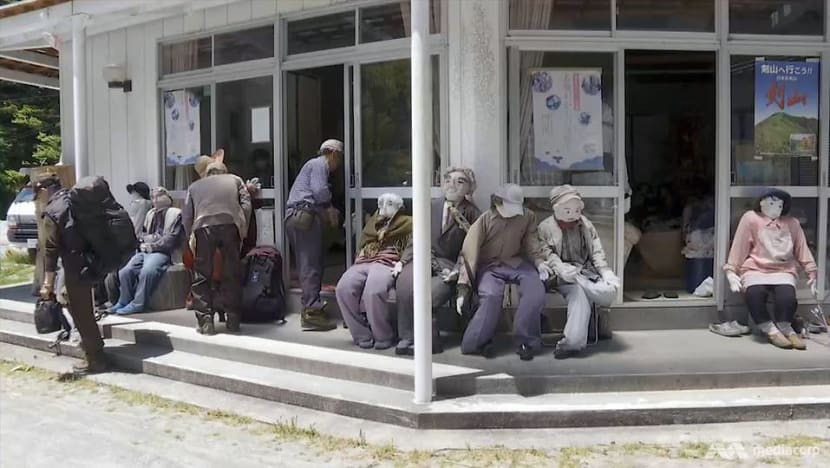 |
| In Japanese village Nagoro, life-sized dolls outnumber the living. Japan’s population is projected to shrink by almost a third by 2065. (Photo: Mediacorp) |
Leo Lewis
01 Nov 2022
TOKYO: Next year, according to a recent estimate, Japan will have roughly 11 million unoccupied residences — slightly more than the entire residential stock of Australia. By 2038, under one scenario in the same forecast, just under a third of Japan’s dwelling units could lie empty.
A gloomy prognosis for Japan, where spooky, semi-abandoned rural villages already abound, but a portent of much bigger trouble, potentially, for China.
For many economies, “Japanification” may be a vague worry; where bubbles are concerned there is danger. And there’s a warning klaxon that Japan may now be sounding for China relating to the effect of demographics.
The “empty home” research by Nomura Research Institute (NRI) is the latest in a series on Japan’s property market that it and other organisations have generated over many years. Together, they describe an economic landscape that has not really recovered from the collapse of the late 1980s property bubble.
The trauma of that implosion, the failure of regulators to be tough with banks and the ill-composed stew of policies intended to nourish a recovery still cause pain, deflation and distortion.
AGEING AND SHRINKING POPULATION
An unavoidably big part of that arises from demographics. An ageing and shrinking population, with only a small offset from immigration, creates the basic structural pressure for a housing surplus.
This is amplified by decades of housing policy that has ignored population decline, failed to remove unwanted or unusable property and encouraged construction to preserve gross domestic product.
One of the more striking assumptions of NRI’s forecast (which includes unoccupied second homes and unoccupied properties for rent or sale) is that, even as the number of empty units roughly doubles between 2023 and 2038, construction will add more than 8 million new ones.
From 2023, figures from the National Institute of Population and Social Security Research suggest, that should become far harder to justify.
Although Japan’s population has been shrinking for over a decade, the impact on housing surplus has been temporarily damped as the total number of households has continued to rise (because of more people living alone and with greater longevity) and is only due to peak next year (at 54.19 million).
After that, the housing surplus will rise more acutely and the downward pressure on property prices strengthen.
CAN CHINA AVOID A JAPAN-STYLE PROPERTY CRISIS?
For China, the biggest demographic issue now may be how to avoid a Japan-style property crisis, as the strategist Simon Powell argues in a research note published recently by Jefferies. Based on population projections, he says, China may already have enough housing to meet its future needs.
As an economy with an unprecedented dependence on housebuilding, it risks making the same mistake as Japan, simply carrying on with new construction as if demographics did not matter.
Then the risk becomes a significant collapse in prices and the sort of correction with which Japan is still wrestling.
“There is an important resemblance between Japan in 1990 and China today: A certain kind of growth has reached the end of the line,” says Powell, noting that China’s working-age population has already started to fall, and that both countries have depended on a development model based on sky-high levels of investment and accumulation of physical assets.
There are two main struts in Powell’s argument. The first is that Japan’s experience suggests a strongly asymmetric relationship between population change and housing prices.
On the way up, research suggests that every 1 per cent increase in population growth is associated with a 5 percentage point increase in house prices. In reverse, a 1 per cent decline in population produces a much larger price decline.
The second part is that marriage in China is on a downward slope, dropping from 13.5 million in 2013 to 7.6 million in 2021. Unlike in Western OECD countries, where the ratio of children born to unmarried couples can be as high as 60 per cent, in China it is probably closer to the Japanese level of below 3 per cent, says Powell.
Fewer marriages may, as in Japan, produce a short-term rise in household formation, but ultimately it more likely guarantees the continued falling birth rate.
There are measures that Beijing can take, and factors that may significantly delay China’s replication of Japan’s experience. There are, clearly, important differences between the two economies: Even as the hissing sound from China’s bubble has become louder, it has sustained higher economic growth rates than Japan did at the equivalent point in its history.
["Higher Economic Growth Rates" is not the same as "Higher per capita income". Japan's per capita GDP in 2021, is about US$39,000. China's is about US$12,500. (In 1995 when Japan started to stagnate and decline, its per capita GDP was US$44,000. China's then was only US$600 but it was still growing. US per capita GDP was actually lower than Japan's at $29,000. But US continued to grow while Japan stagnated and decline, and by 2001, the US had exceeded Japan, or Japan had slipped below the US. Up to 1995 when Japan had been growing, its per capita growth rate (then) was higher than China's (now). So no. China is NOT in a better position than Japan then. Not at the per capita basis. ]

No comments:
Post a Comment